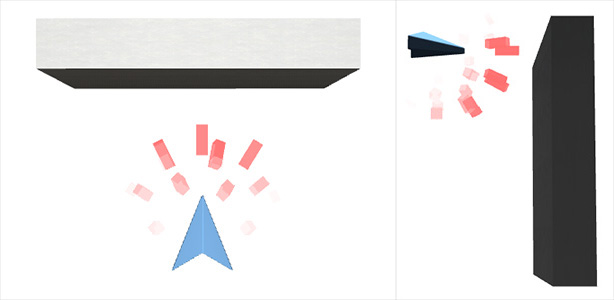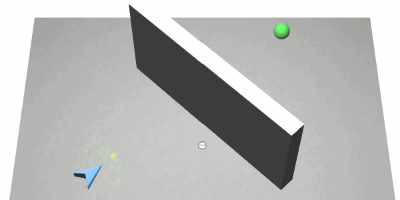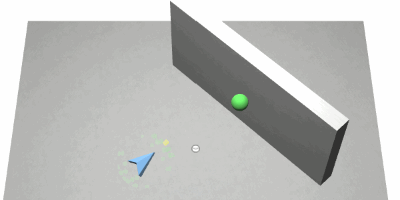front-end / back-end: AIMSeekBounds | SeekBounds
inherits from: AIMRadiusSteeringBehaviour | RadiusSteeringBehaviour
front-end / back-end: AIMFleeBounds | FleeBounds
inherits from: AIMRadiusSteeringBehaviour | SeekBounds

Note that the inspector of Flee Bounds is equivalent to the inspector of Seek Bounds.
For many cases, the simple Seek behaviour might be sufficient, but for many other cases, the collider information of an object needs to be considered, too. Therefore, Seek Bounds was made. Figure 1 illustrates the functionality of this behaviour. A Ray-to-Bounds test is performed from every receptor to the objects bounds. The hit distance is mapped like the classic Radius Steering Behaviour additional to the SensitivityOffset. Flee Bounds works exactly like Seek Bounds except that it inverts the response direction.

Figure 1: Shows the results of Seek Bounds applied to an agent in front of a wall. The left image shows a top view while the right image shows a side view. The wall's boundary correlates with the agent's receptors.
This component has got the following specific properties.
| Property | Description |
|---|---|
BoundsType | The applied bounding box model: either axis-aligned bounding box (AABB) by collider, oriented bounding box (OBB) by collider or OBB by visual bounds (sprite/mesh). In order for this to work with meshes, a received object must not be static, or otherwise, no visual bounds can be received. For more details, have a look at the bounding box remarks in Planar Avoid Bounds. |


Since we use ray-to-bounds tests, this behaviour is computational more expensive compared to classic Seek and Flee. This being said, you should prefer Seek and Flee wherever possible.